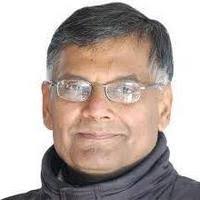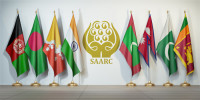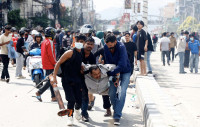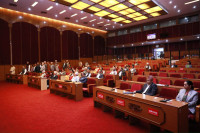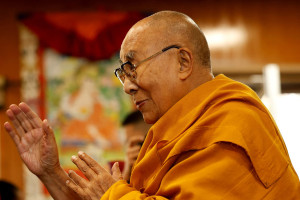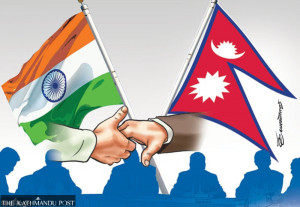Columns
Interpreters of the world, write!
The externalised and marginalised of the world, be your own interpreters and tell your own stories.
CK Lal
Prime Minister Khadga Prasad Sharma Oli heads a party that still likes to call itself Communist Party of Nepal (Unified Marxist-Leninist), better known by the acronym CPN (UML) rather than its official name. That’s just as well, since the letter ‘C’ in the name of the party has begun to appear as if it stands for communalism rather than communism.
Leader of the main opposition in the Parliament is Pushpa Kamal Dahal, who has continuously been the supremo of the Communist Party of Nepal (Maoist Centre) since its founding. The header of its website proclaims the Nepali equivalent of communist slogans “Workers of the world, unite!” and “Long live Marxism, Leninism and Maoism”.
Despite two of the three biggest political parties of Nepal claiming their ideological origin to Marxism, the May Day this year was observed with gaiety while even the political class appeared to have forgotten to mark the birth of Marx with a public programme. Perhaps it would have been opportune to commemorate the day with a collective reflection over the relevance of Marxism in the age of triumphant free market fundamentalism, assertive Hindutva and resurgent monarchism in the national politics. However, the transformation of Nepali ‘communists’ into upholders of Sanatan secularism is so complete that they no longer find it necessary to revisit their ideological roots.
Even though mostly conceptualised and expressed in German, Karl Marx (born May 5, 1818, Prussia—died March 14, 1883, England) is justly famous for his quotable quotes. Some of his pithy lines would probably put the wittiest of Twitterati or the smartest of influencers on Instagram to shame. The most famous of Marx’s expressions appears as “Workers of All Lands Unite” upon his tombstone at the Highgate Cemetery in London.
The monument of one of the greatest thinkers of the 19th century also contains his oft-quoted declaration: “Philosophers have only interpreted the world in various ways. The point, however, is to change it.” The assertion in the inscription is ironical, because along with his lifelong friend and closest collaborator Friedrich Engels, Marx interpreted the world in a particular way— “The history of all hitherto existing society is the history of class struggles”—and ignited a process that changed half the world directly and almost all of it indirectly in the very next century.
One may have reservations about various variants and mutations of Marxism such as Leninism, Maoism, Pol Potism, Ho Chi Minh thought, Castrismo, Chavismo, Madurismo, Jucheism or even Nepal’s very own Prachand Path, but it’s extremely difficult to make sense of the world after the French Revolution without reading at least some of the considerable body of works of the genius German exile in London.
Apparently, interpreters of the past who analyse the present and outline different possible futures matter as much—if not more—as the doers who learn things by doing. The “Six Honest Serving Men” of Rudyard Kipling’s poem has since become the 5W1H (who, what, when, where, why and how) structure of information gathering. Every question of the framework is equally important, but it’s the curiosity inherent in ‘why’—the Tell Me Why series of children’s books being an illustrative example—that helps a person make sense of the world. Unfortunately, in an age obsessed with ‘how to …’ of coping with the complexities of everyday life, it has become passé to question why.
Interpretive journalism
When asked in bewilderment, why is often a cry for making sense of the data—the stepping stone to wisdom on knowledge pyramid—and trying to deepen one’s understanding. Knowledge propels a person to think and then take a considered decision. Perhaps that’s the reason subordinates are told, like the ill-fated soldiers in Alfred Lord Tennyson’s poem “The Charge of the Light Brigade”—Yours not to reason why, yours but to do and die!
Even though knowledge doesn’t necessarily generate insight—wisdom comes to some through a complex process of experience, learning, reflection, exchange and realisation—to know is to act responsibly. While canons of ethical journalism such as accuracy, balance and fairness continue to be as important as ever, it’s time to realise that practitioners of the profession are no longer just gatherers and conveyers of information.
With the ‘news’ losing its newness by the time it reaches the audience, media persons will have to transform themselves from being mere objective messengers to rational meaning-makers. Most journalists of the old school have been quick to adopt the attention-grabbing techniques of asocial media, but many of them appear to be either unwilling or incapable of analysing, contextualising and explaining events without overt bias or covert prejudices.
Information gathering satellites (IGS) hovering over the globe that capture ultra-high density images and transmit them to individual receivers on wearable devices will reduce the workload of field reporters. Large Language Models (LLMs) will help Artificial Intelligence (AI) systems process massive datasets and generate personalised content for consumers of information.
Come to think of it, a Very Low Earth Orbit (VLEO) may spot someone in the park staring at a butterfly and prompt a chatbot produce poetic lines that will be delivered instantaneously to interested listeners everywhere! It’s difficult to predict the trajectory of technological leap with evolving skills becoming obsolete by the time one has begun to appreciate its implications. However, there is one thing that human beings will probably always do better than all humanoid robots—lace (Love, Authenticity, Courage and Empathy) their expression with sincerity.
Compassionate journalists
First, the good news: Despite falling 16 places from 74th in 2024 to 90th, Nepal continues to boast of the freest media in South Asia according to the recently published RSF World Press Freedom Index 2025. The rider in the report isn’t so uplifting: With a total score of 55.2, the Press Freedom Index of Nepal is described as “problematic”, which barely scratches past the 55 points line that would have led to the characterisation of being in a “difficult situation”.
Even though the ‘godi media’ remains a butt of ridicule in the profession for ‘afflicting the afflicted and comforting the comfortable’ rather than performing its duty towards society, India with a score of 32.96 has surprisingly improved its ranking from 159 to 151st this year. Honourable exceptions apart, everything that can go wrong with the functioning of the free press has gone wrong in the Indian media over the last decade. That offers a lesson to journalists elsewhere including Nepal about what not to do in a fledgling democracy.
Instead of a national media that needs to celebrate social and cultural diversities of country, nationalist media portrays the nation under threat and promotes jingoism, chauvinism and majoritarian chauvinism. Pitfalls of corporate ownership notwithstanding, composition of newsrooms affects the way media covers diversity, equity and inclusion (DEI) issues.
The Oxfam India-Newslaundry’s Report titled “Who tells our stories matters: Representation of Marginalised Caste Groups in Indian Media” found out in 2022 that around 90 percent leadership positions in print, TV and digital media of India were occupied by the so-called General caste groups. The situation in Nepal is perhaps no better. The externalised and marginalised of the world, be your own interpreters and tell your own stories.




 20.12°C Kathmandu
20.12°C Kathmandu